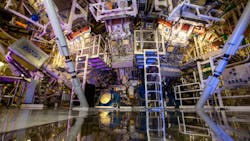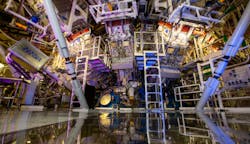Scientists used the National Ignition Facility at Lawrence Livermore National Lab to squeeze a microscopic sample of copper samples under 30 million atmospheres in less than a billionth of a second. This tripled the sample’s density, creating the densest object on the planet for a brief moment in time.
Preparing the samples, creating the pressure, and measuring the results required leading-edge equipment and diagnostics. For example, researchers used diamond turning machines to generate microscopic copper “stair steps”, whose surface roughness surpassed optical qualities and precision metrology to measure sample thickness to 1 billionth of a meter. During the experiment, they tracked the copper sample traveling at 50,000 mph using a velocity interferometer—the world’s most sophisticated radar gun.
One of the team’s goals was to benchmark copper’s compressibility under extreme conditions so other scientists working in high-energy-density physics can use copper as a high-precision standard. This is much like the National Institute of Standards and Technology providing well-calibrated standards to industry, academia, and government.
To determine how copper’s stiffness responds to increasing pressure, the research team took a series of X-ray images to monitor the crystalline structure as the copper was compressed. It also measured how the speed of sound waves through the copper as it was squeezed. From these measurements, the team benchmarked the behavior of copper at extreme conditions and developed a microscopic interpretation of its quantum behavior.
The experiments showed that researcher can accurately predict the behavior of copper to extreme conditions, according to the team. The researchers also suspect this behavior may be common in other noble metals (metals with nearly spherical electron orbitals with one conduction electron per atom).

